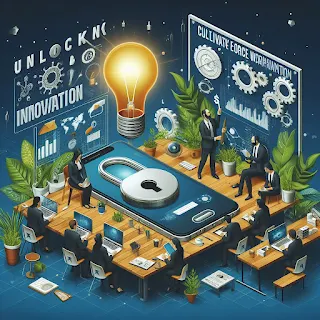Unlocking Innovation: Cultivate Workplace Creativity
When it comes to fostering innovation and driving growth in the workplace, one crucial factor often goes unnoticed: creativity. It's time to challenge the common belief that creativity is simply a nice-to-have skill, and instead, explore how it can be the key to unlocking innovation and propelling your business forward.
How can you cultivate creativity in the workplace? What are the strategies and techniques that promote innovative thinking among employees? In this article, we will delve into the world of cultivating workplace creativity. By understanding the link between creativity and innovation and implementing practical strategies, you can foster a culture of creativity that will drive innovation in your organization.
{getToc} $title={Table of Contents}
Understanding the Link Between Creativity and Innovation.
Creativity and innovation are two essential components that drive success and growth in today's ever-changing business landscape. They are interconnected, with creativity serving as the foundation for innovation. An innovative workplace culture is one that values and encourages creativity at work, fostering a culture of creativity that fuels innovation.
When individuals are empowered to express their creative ideas and perspectives, they are more likely to think outside the box and come up with innovative solutions to challenges. By cultivating a culture of creativity, organizations can tap into the collective creativity of their employees, unlocking a wealth of innovative ideas and approaches.
An innovative workplace culture is characterized by a supportive and open-minded environment that nurtures creativity. It encourages collaboration, experimentation, and risk-taking, providing employees with the freedom to explore new possibilities and challenge existing norms. In such a culture, individuals feel empowered to share their thoughts, contribute their unique perspectives, and pursue innovative ventures.
By fostering creativity at work, organizations not only create an environment that breeds innovation but also develop a competitive edge in the market. In a constantly evolving business landscape, the ability to innovate is crucial for staying ahead of the competition. By cultivating a culture of creativity and fostering creativity at work, organizations can position themselves as leaders in their industries.
Throughout this section, we will explore the characteristics of an innovative workplace culture and provide insights into how organizations can cultivate a culture of creativity. By understanding the link between creativity and innovation, businesses can pave the way for continuous growth, development, and success.
Strategies for Cultivating Creativity in the Workplace.
Unlocking the full potential of innovation begins by fostering a culture of creativity in the workplace. By implementing practical strategies that promote creative thinking and collaboration, organizations can drive innovation and stay ahead in today's competitive business landscape.
Nurturing an Environment that Inspires Creativity
To cultivate creativity at work, it is essential to create an environment that inspires and nurtures innovative thinking. This can be achieved by:
- Encouraging Curiosity: Promote a sense of curiosity among employees by encouraging them to explore new ideas, take risks, and ask questions.
- Providing Freedom and Autonomy: Grant employees the freedom and autonomy to experiment, make decisions, and pursue their own creative approaches.
- Embracing Diversity: Foster a diverse and inclusive workplace where different perspectives and ideas are valued, as they often spark innovative solutions.
Enhancing Collaboration and Idea Sharing
Collaboration and idea sharing are key drivers of innovation in business. Organizations can amplify creativity by:
- Promoting Cross-Functional Collaboration: Encourage employees from different departments or teams to collaborate and share ideas, enabling fresh perspectives and interdisciplinary approaches.
- Creating Collaborative Spaces: Designate areas or provide tools that facilitate informal interactions and brainstorming sessions, fostering the exchange of ideas.
- Implementing Idea Management Systems: Employ digital platforms or systems that allow employees to submit, discuss, and refine their ideas, promoting transparency and collaboration.
Supporting Continuous Learning and Skill Development
Continuous learning and skill development are vital for fostering innovation. Organizations can support the growth of creativity by:
- Offering Training and Workshops: Provide employees with opportunities to enhance their creative thinking skills through training programs and workshops.
- Promoting Knowledge Sharing: Encourage the sharing of knowledge and expertise among employees through mentoring programs, lunch-and-learn sessions, or internal communities of practice.
- Creating a Safe Learning Environment: Foster a culture that embraces experimentation and learning from failures, allowing employees to take calculated risks and learn from their experiences.
By implementing these strategies and fostering creativity at work, organizations can cultivate an environment that not only inspires innovative thinking but also drives business growth and promotes innovation in the workplace.
Nurturing a Culture of Innovation: Best Practices.
Creating a workplace culture that fosters innovation is vital for businesses to stay competitive in today's fast-paced world. To drive innovation in the workplace, organizations must cultivate a culture of creativity that encourages experimentation and risk-taking. Leadership plays a crucial role in setting the tone and shaping the culture, helping to inspire and empower employees to think outside the box.
One best practice for fostering innovation is to provide employees with the resources and support they need to explore new ideas. This can include dedicated time for brainstorming sessions, access to training programs that promote creative thinking, and the provision of tools and technologies that facilitate innovation.
Another key aspect is creating a safe environment where employees feel comfortable sharing their ideas and perspectives. By encouraging open communication and actively listening to employee feedback, organizations can foster a culture of psychological safety that nurtures creativity and fuels innovation.
Furthermore, recognizing and rewarding innovative ideas and contributions is essential for driving ongoing innovation. By celebrating and showcasing successful innovations, organizations encourage a positive mindset towards creativity and inspire others to take risks and think innovatively.

